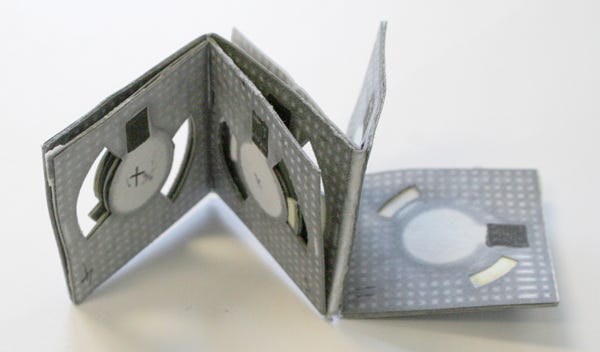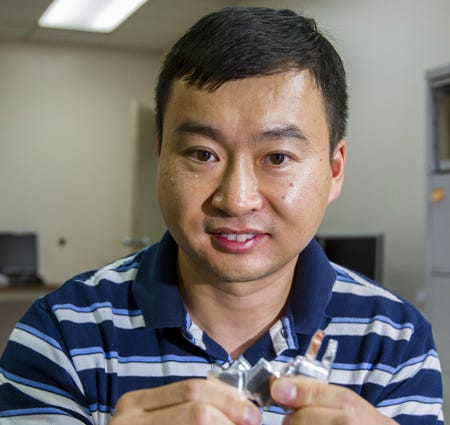The Greatest Medtech Innovation of 2015
July 8, 2015
An ancient art form has potentially solved a major design hurdle for wearable devices. Our readers think it could have a profound effect on medtech. A series of surveys found them picking it as the best technology of the year so far.
Chris Newmarker
|
Binghamton University engineer Seokheun Choi needed his paper-based biobatteries to be able to fit in more compact spaces. He found the answer in origami. (Image courtesy of Binghamton University) |
How can you make solid lithium-ion batteries stretch? Or what about getting a string of paper biobatteries to fit in a smaller, more compact space?
In both cases, researchers found the answer in origami--a paper-folding form of art that has been practiced in Japan since at least the 17th century.
Their origami-based innovations, announced this year out of Arizona State University (lithium ion batteries utilizing the kirigami form of origami) and Binghamton University (origami-based paper biobatteries), seem to have struck a chord with Qmed/MPMN readers. Batteries inspired by origami came out on top in a series of surveys asking our readers to identify the new technologies most likely to have a profound effect on medtech in coming years. They beat out such amazing developments as a lab-grown biolimb and Terminator 2-inspired 3-D printing.
Overcoming battery-related design hurdles seems to really matter, especially when it comes to the fast-growing field of medical technology wearables.
Demand for such wearable devices is expanding in part because as the healthcare system works to lower costs and improve overall patient outcomes. Health tracking, especially when it comes to chronic conditions such as diabetes and heart disease, is set to play an important role.
But finding the right battery technology for wearable devices can be a tricky matter, says Bill Evans, president of Bridge Design (San Francisco).
"Most wearables are going to require power, and for some it will be as much power as possible crammed into shapes that are awkward or needs to flex as the user moves," Evans said. "I think a battery like the kirigami inspired design from the ASU team has a lot of potential in this emerging wearables market because of its ability to flex while in use, yet still offer the higher performance and well understood characteristics that lithium chemistry offers."
Eric Topol, chief academic officer at San Diego-Scripps Health, agrees that better battery technology would help developers of wearable devices to have a significant impact on modern healthcare: "There's no shortage of tech innovation when it comes to digitizing human beings."
How Origami Can Help
|
Hanqing Jiang, an associate professor at Arizone State University, holds some of the kirigami-inspired batteries that he and doctoral students Zeming Song and Xu Wang developed. (Image courtesy of ASU) |
In the case of the Arizona State University researchers, they started out two years ago with the Miura fold of origami, says Hanqing Jiang, an associate professor of engineering.
The method, named after its inventor, Japanese astrophysicist Koryo Miura, involves folding a flat surface into a smaller area.
"Origami and kirigami belong to the fine arts. They have only been used by engineers very recently," Jiang said.
Miura seemed to have potential when it came to providing some elasticity to otherwise rigid lithium-ion batteries. But Jiang and his colleagues, doctoral students students Zeming Song and Xu Wang, soon ran into a snag: Miura is stretchable, but the height changed significantly after repeated stretching--not a good situation if you want a device that stays within certain parameters.
The solution Jiang, Song, and Wang hit on was a form of origami called kirigami that involves both folding and cutting. Kirigami enabled cutting and twisting to create interlocking structures of lithium ion batteries that were stretchable. The design template enables the batteries to be stretched to more than 150% of their original size, while still maintaining full functionality.
Jiang and colleges even sewed the kirigami-based prototype battery into an elastic wristband attached to a smart watch. The battery was able to fully power the watch and its functions--including playing video--as the band was being stretched. Jiang thinks there is potential to use such a stretchable, origami-based battery to replace a whole host of bulky and rigid wearable batteries.
"We really want to get some insights from people who are working on the biomedical applications. How could they use this technology?" Jiang said.
Origami also proved useful for Seokheun Choi, assistant professor of electrical and computer engineering at Binghamton University (Binghamton, NY).
Choi came up with paper-based biobatteries that he thinks have potential to power sensors and other lower-power medical devices in developing countries. "I expect this battery to be used regions with limited resources," he said.
The batteries include a air-breathing cathode created by spraying nickel onto a side of ordinary office paper. The anode is a screen printed with carbon paints. A drop of any type of bacteria-containing liquid can produce electricity on the paper biobattery.
There was a significant design challenge, however. Choi needed to string a few of these paper batteries in a row in order to produce enough microwatts to be useful. A biosensor has space constraints. Choi, who earned a doctorate from Arizona State University, was aware of Jiang's work and the work of other engineers who had used origami. It provided an elegant solution for Choi.
"You could reduce the size by folding techniques. ... I could connect 28 batteries to increase power density using origami technologies. I think this technique is a great potential tool for any biobattery or any battery using paper-based substrates. It has a huge amount of potential," Choi said.
Stretchability over Durability?
Origami-inspired batteries could help free electronics from its rigid barriers, said Derek Mathers, business development manager at Worrell Design (Minneapolis). But Mathers wonders whether medical device companies want such flexibility for batteries.
"In my experience, these companies (as well as the mass-producers of smartwatches like Apple and Samsung) are much more interested in extending battery lives as much as possible instead of extending their elongation properties," Mathers said. "Think about this: wouldn't you rather drastically extend the life of a pacemaker, stimulator, or implanted electronic rather than making it more flexible?"
Mathers notes that the more complicated the shape of the battery, the less volume and thus less energy can be fit into it. "The tradeoff is that a cube-shaped rigid lithium-ion battery has much more volume and a lot less packaging than a flat, flexible one," he said.
Mathers suspects that the best medical device application for flexible batteries might be epidermal electronics on the surface of the skin, where recharging or replacing is a non-issue compared to implanted devices. "This also maximizes the utility of having a flexible, conformal battery to move along with you," Mathers said.
The ability of the origami batteries to stretch is impressive, though, says Tom Kramer, president of Kablooe Design (Coon Rapids, MN). "There are so many electronic innovations, but in the recent past they've been handicapped by the ability of the batteries to perform."
Refresh your medical device industry knowledge at MEDevice San Diego, September 1-2, 2015. |
Chris Newmarker is senior editor of Qmed and MPMN. Follow him on Twitter at @newmarker.
Like what you're reading? Subscribe to our daily e-newsletter.
About the Author(s)
You May Also Like



.png?width=300&auto=webp&quality=80&disable=upscale)
